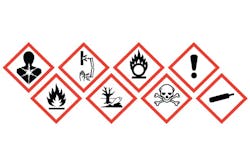After nearly two decades, the Occupational Safety and Health Administration (OSHA) has revised its hazard communication standards for businesses—a change that will require new training for all collision repair shop employees this year.
The new requirements will not be put into effect until 2016, as part of a four-step process over the next three years to get businesses up to speed. The first step requires all shops to complete employee training on the new standards by Dec. 1.
A lot has changed regarding the manufacturing, distribution and end-use of chemicals since OSHA last updated its hazard communications standards for workplace chemicals in 1994, says Brandon Thomas, chief operations officer and risk management strategist for GMG EnviroSafe, an organization that assists shops with governmental and regulatory compliance issues.
Some of the changes include the classification process for hazardous chemicals, and standardized words and pictograms on labels to define various families and risks of chemicals. All of this has resulted in new format, structure, language, and content areas of chemical manufacturer Safety Data Sheets (SDS)—formerly known as Material Safety Data Sheets (MSDS).
Thomas says 80 percent of the new SDS forms will include new information regarding ecology, disposal, transport and regulation issues of chemical hazards compared to the old MSDS forms.
Shop Training
Thomas says the revised standards are an important regulatory change that affects every body shop in the country. He outlines the minimum training required for staff by the end of the year:
Label changes for chemical containers. OSHA has standardized the “danger” and “warning” words used on labels, as well as the design of pictograms that illustrate various personal and environmental hazards. In addition, OSHA now requires precautionary and personal protective equipment needs to be outlined on chemical labels.
“Shops should explain what these things mean, and what the significance is to employees,” Thomas says.
First-aid procedures. Employees must know how to quickly get necessary information to mitigate health and environmental risks in the event of a chemical accident, spill, leak, ingestion or exposure, Thomas says.
Significance of multiple pictograms on labels. Thomas says one chemical now could include up to four hazard warnings on the label under the new standards. Employees must understand precautionary, storage and first-aid best practices for chemicals with several different warnings.
Format and content of SDS. OSHA’s new SDS format requires 16 standardized sections. Employees must know how the SDS is organized and what type of information is included within each section.
Relationship between chemical labels and SDS. Thomas says chemical labels aren’t able to provide all necessary information.
Employees should be trained on how to cross-reference labels with the SDS if they have questions or need information.
“Keep a paper trail in your records that documents when the training occurred, who attended, what was discussed and who the instructor was,” Thomas says.
Designate a Manager
For shops to adequately prepare for the hazard communication conversion, Thomas suggests to designate a shop staff member as the SDS library manager—an office manager, production manager or customer service representative.
He says one specific person should be charged with the handling, managing and record-keeping of the new SDS forms for your facility due to the plethora you will receive. With hundreds of chemicals in use at your facility, and up to 10 pages of SDS information for each, “it will get out of control very quickly if you have several people overseeing it.”
Your SDS library manager does not require any special training or certification, Thomas says. They only need the capacity to complete the following three responsibilities:
• Compare MSDS to SDS upon receipt of chemicals. Thomas says it’s the shop’s responsibility to identify whether hazards have changed from the old MSDS to the new SDS requirements. As the library manager receives chemicals with the new SDS, they need to go into the old MSDS library and compare the two documents.
“You need to be vigilant over the next few years to identify whether OSHA’s criteria has introduced new workplace hazards even though it’s the same type of product you’ve always bought,” Thomas says.
• Communicate differences to employees. If the hazard has changed, the library manager is responsible for identifying every new safety, health and personal protective equipment requirement that must be communicated to employees.
• Keep information readily accessible for employees. Thomas says both the MSDS and SDS information must be accessible to all staff members until the transition is officially completed in June 2016.



